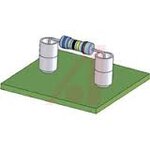T
treez
Guest
Thanks, sorry to keep asking but youre raising some incredibly good points here…specially since we are doing a load of smps’s on a pcb that’s not mounted with a heatsink at the bottom of itself, and with 70degC internal ambient temperature and no vents in the enclosure, and all of our components are SMT only.That is impossibly hot, not only for the solder but the board. it will go black very quickly and probably de-laminate.
Do you know what is the temperature of the PCB at which the blackening and delamination that you spoke of starts happening?
